The planned third mowing was supposed to happen the second week of October. And then I started to see more Monarchs, Swallowtails, other orange and yellow butterflies and moths, grasshoppers, Praying Mantises, Bumblebees, Honeybees, Wasps, and Finches. The construction-road portion of the meadow was flowering like mad, and the existing meadow flowers were still going strong. I did not expect the amount of energy and activity that we witnessed and decided cutting the field could wait. The end of the third week brought a widespread frost that killed the tall annuals and sent many of the wildlife to hibernation or warmer climes. This did not mean the end of flowers. Down below, in the protection of the taller plants and grasses, tiny flowers continued to bloom and honeybees were 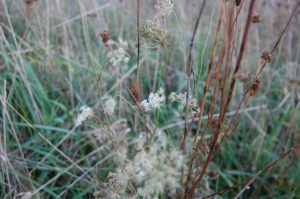
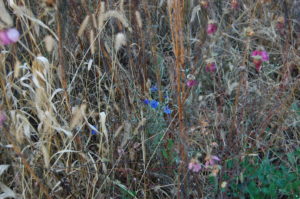
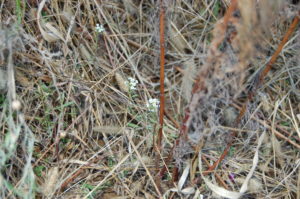 finding them. That left the question of when to mow.
finding them. That left the question of when to mow.
Of course, now I had another challenge: Praying Mantis egg cases. These cases look like sacs of mocha foam. Secured about 20 inches above the ground on stalks of shrubs and grasses, the eggs are protected from being covered by most snows and shed rain by their unique pointed shape. The mowing was to be a mulching mow that tears the grass and plant material into small pieces to allow for easy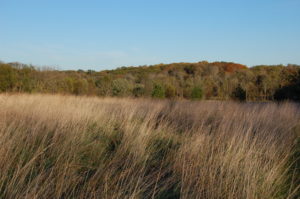
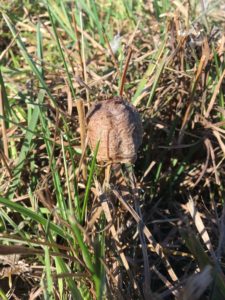 decomposition. Seeds would be distributed well but egg cases would be vulnerable to destruction. I decided to hold off on mowing till I could find and relocate many of the cases. It is no mean feat finding the egg cases as they are well camouflaged against the dormant grasses. I found about 40 of them. Cut the stalks that they were attached to at the base and then attached them, pointy side up, to nearby shrubs and trees with twisty-ties. There they would be safe from the mowers and be near their food source when they hatched. It was my little reward to them for the hard work that they do in controlling the insect population.
decomposition. Seeds would be distributed well but egg cases would be vulnerable to destruction. I decided to hold off on mowing till I could find and relocate many of the cases. It is no mean feat finding the egg cases as they are well camouflaged against the dormant grasses. I found about 40 of them. Cut the stalks that they were attached to at the base and then attached them, pointy side up, to nearby shrubs and trees with twisty-ties. There they would be safe from the mowers and be near their food source when they hatched. It was my little reward to them for the hard work that they do in controlling the insect population.
Mowing would have to wait till November.
November: Harvest Time and Mowing
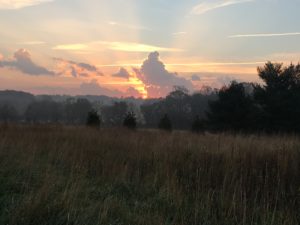 Most of the seeds in the meadow distribute themselves and have the capacity or need to weather the winter on the ground. Some seeds are either too tender to over-winter or may be better placed somewhere else in the meadow. These I collect and store. Hand-collecting seeds from flowers is a wonderful task. If treated well, every one of those seeds has the potential to be a new, wonderful plant in the next growing season. I let most of the Milkweed fly off on its own but collected a large freezer-bag full to give away to friends and family for their Monarch borders…holiday presents! The impending fall mow brought a sense of urgency to the task, but not too much urgency to miss seeing the sky show,
Most of the seeds in the meadow distribute themselves and have the capacity or need to weather the winter on the ground. Some seeds are either too tender to over-winter or may be better placed somewhere else in the meadow. These I collect and store. Hand-collecting seeds from flowers is a wonderful task. If treated well, every one of those seeds has the potential to be a new, wonderful plant in the next growing season. I let most of the Milkweed fly off on its own but collected a large freezer-bag full to give away to friends and family for their Monarch borders…holiday presents! The impending fall mow brought a sense of urgency to the task, but not too much urgency to miss seeing the sky show, 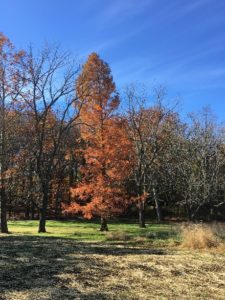 watching the birds hunting for their prey – some for seeds, some for small mammals – listening to the corn and the leaves, smelling the hint of winter in the air, tasting the apples from the trees, and feeling the textures of the plants
watching the birds hunting for their prey – some for seeds, some for small mammals – listening to the corn and the leaves, smelling the hint of winter in the air, tasting the apples from the trees, and feeling the textures of the plants
Cosmos, Coreopsis, Corn Flower, and Cleome seeds grace my seed-storing shelves, waiting for distribution in the spring.
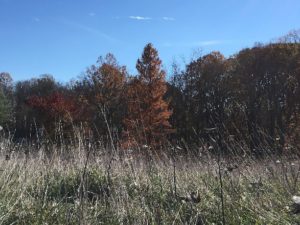 The sharp light of November makes the edges of the meadow almost glow with color. A Cypress sits at the bottom edge of the meadow and is part of the ‘borrowed’ landscape that surrounds the meadow, grounding it and giving it a sense of place.
The sharp light of November makes the edges of the meadow almost glow with color. A Cypress sits at the bottom edge of the meadow and is part of the ‘borrowed’ landscape that surrounds the meadow, grounding it and giving it a sense of place.
A mid- November surprise were the butterflies who were still flitting about in the field visiting the small flowers that were tucked safely underneath the grasses. There had only been light frosts so far, none of the hard, killing frosts that force the garden to hibernate, so I guess the butterflies were taking advantage of last little bits of sustenance.
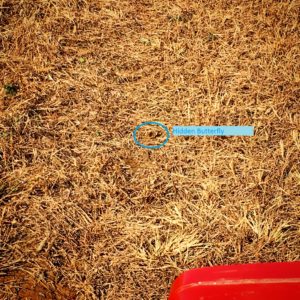
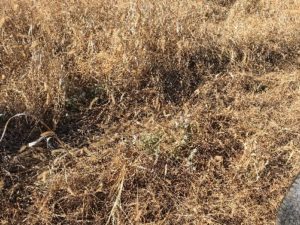 Three Downy Woodpeckers took up residence on the edge of the meadow in mid-November filling the air with the sounds of drilling and their calls to each other.
Three Downy Woodpeckers took up residence on the edge of the meadow in mid-November filling the air with the sounds of drilling and their calls to each other.
Late butterflies or not, the meadow needed to be mowed. The late-November mowing day brought the first hard, killing frost of the season. At daybreak, even the small, sheltered flowers were covered with a lace of rime. The drooping grasses gleamed in the early sunlight with beads of iridescent semi-frozen moisture. Even though there was lots of discussion with Fernando, the tractor operator, who argued that the land might look better at 4-6 inches, the tractor was set to cut at 8-10 inches. (Fernando never really liked the meadow grass. This was his big chance to bring it under control.) By slowly running the tractor back and forth across the 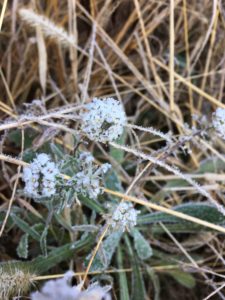
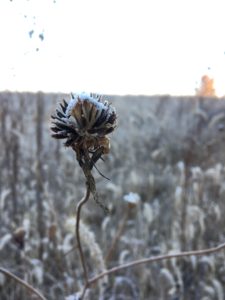
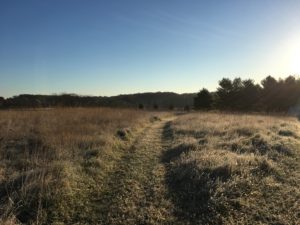
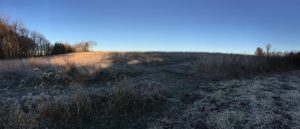
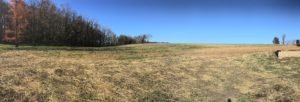 field the cut
field the cut 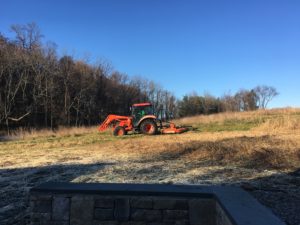 material was chopped up into a fine ‘mulch’ and left on the land. Over the course of the winter, much of this material would break down and feed the soil. The mulch also contains seeds which will overwinter and then sprout and grow next season.
material was chopped up into a fine ‘mulch’ and left on the land. Over the course of the winter, much of this material would break down and feed the soil. The mulch also contains seeds which will overwinter and then sprout and grow next season.
After the mowing was complete there was the sound of crickets down in the grasses as a Dragonfly flitted by. Yet another late November surprise!
December – The Field Sleeps
The December field is quiet but there are many sounds from the surrounding woods and from overhead: the honking of Canada Geese as they fly, the rustling of oak leaves as the wind blows, the tinkling of the stream as it flows through the ice.
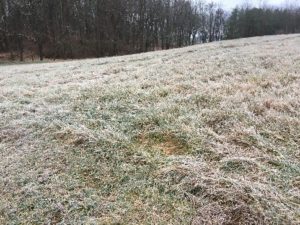 The smell of the winter field is so different: sharp, filled with that ozone-y scent of coming snows, the earthy smell of compost spread on neighboring fields, the intermittent scent of pine on the wind.
The smell of the winter field is so different: sharp, filled with that ozone-y scent of coming snows, the earthy smell of compost spread on neighboring fields, the intermittent scent of pine on the wind.
The mown field lies covered with rime in the early morning punctuated by bright green, melted spots where deer have bedded down overnight. Later in the day the field looks almost spring-like after being warmed by the sun. It is easy to see the undulations of the land.
As the field sleeps, we plan for the next growing season – updating planting plans, researching and ordering seeds and seed mixes, setting up planting schedules, hoping for a blanket of snow to protect the soil from winter winds. Rainfall was limited this past year and the area was close to a drought declaration. Slow-melting snows would provide much-needed moisture.
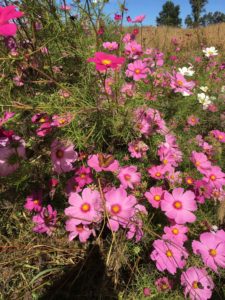

{ 1 trackback }